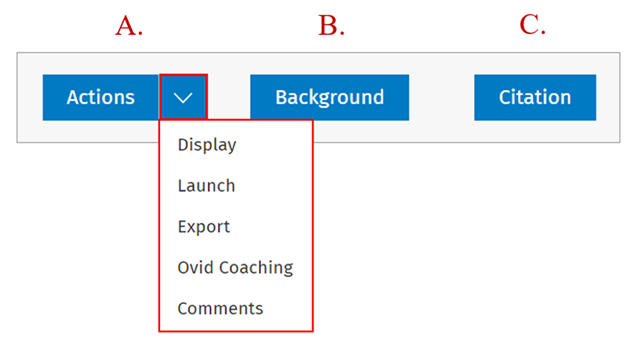Background
Embase, produced by the academic publishing and information analytics company Elsevier B.V., is one of the largest and most comprehensive Abstracting and Indexing (A&I) database for peer-reviewed biomedical information. The Embase database covers all disciplines of medical and biomedical science as well as Allied Health subjects.
Embase on Ovid – Facts and Figures (1)
- A bibliographic database, Embase is made up of over 43 million database records.
- Over 1.7 million records are added each year.
- Database records are indexed using Emtree, the Elsevier Life Science Thesaurus.
- Conference materials, currently at over 5 million records, have been included since 2009.
- Preprint records, from several sources, have been included since November 2021.
- All database records are indexed using automated means and procedures.
- Records pertaining to diseases, drugs and devices undergo further manual indexing.
Training Session Programme
This Learning Pathway series of training modules draws upon the content and teaching approaches in and behind the learning resource OvidGO! (2). Constructed around a selection of focused searches, the training programme has been designed to achieve the following two objectives,
- to introduce the database, Embase on Ovid, drawing upon where helpful, parallels and comparisons with Ovid MEDLINE,
- to discuss, demonstrate and practice the key features and functionality of the database Embase on Ovid.
(1) Reference for the above is the Embase Indexing Guide 2024.
(2). See https://tools.ovid.com/ovidgo/
When using the Advanced Search mode in a bibliographic database like Embase on Ovid, it is common practice to enter a search term followed by the field or fields you want Ovid to search in. For example, the search expression (adolescent$ or young adult$).ti,ab,kf. (see this Focused Search, line #1) tells Ovid to search for the terms adolescent or adolescents or young adult or young adults in the Title (TI) field as well as the Abstract (AB) and Keyword Heading (KF) fields. This kind of search is referred to as a qualified search in the sense that the instruction to the database is explicit, namely “go and look for these specific terms in these specific fields, that I, the user have selected.”
But as noted in a previous Focused Search, databases vary not only in size but also in terms of their “shape”. You may, for instance, be uncertain about the field composition or layout of the database. In such cases Ovid can help out with the multi-purpose or .mp search. This is described as an unqualified search across a default set of fields which are specific to the database being used.
In this case, the example as used above would be entered as (adolescent$ or young adult$).mp. For Embase the default set of fields across which Ovid will search are:
title, abstract, heading word, drug trade name, original title, device manufacturer, drug manufacturer, device trade name, keyword heading word, floating subheading word, candidate term word.
Because the default fields to be covered by an .mp search are pre-determined, .mp based searches lend themselves well to cross database searching. In this sense the .mp search option is a helpful supplement to Ovid’s Basic Search which is also able to carry search expressions easily across multiple databases.
Practice Suggestions:
- Combine and compare this Focused Search with the Basic Search adolescents adhd ritalin adverse effects {Including Related Terms}. Note that in the Basic Search the search line adolescents adhd ritalin adverse effects {Including Related Terms} has as its search type Basic. But when you limit this line to Five Stars, the search type changes to Advanced. This now enables you to combine this result set with the results in this .mp example. Do the numbers differ greatly?
- Use the Change option to run this Focused Search through Ovid MEDLINE. Do both versions of the search, i.e. the lines using .ti,ab,kf. as opposed to .mp, run properly? How could you easily compare the results obtained in Ovid MEDLINE with those from Embase on Ovid?
- Use the Change option to run this Focused Search through APA PsycInfo. Do both versions of the search, i.e. the lines using .ti,ab,kf. as opposed to .mp, run properly? How can you tell? Identify two markers that tell you.
Reviewers:
Primary: Michael Fanning
Secondary: Charlotte Viken
Review Date: 2025-03-12
Expiry Date: 2026-03-10
Original search produced by:
Ovid Training Team
References:
Embase Indexing Guide 2024
https://supportcontent.elsevier.com/RightNow%20Next%20Gen/Embase/Embase_Indexing_guide_2024.pdf
OvidGO! / Skills Videos / General Introduction
What is a bibliographic database?
What is the structure of a database?
What is Ovid MEDLINE?
What are Boolean Operators?
What are wildcards?
Subject heading searching
OvidGO! / Skills Videos / Embase Specific
What is Embase
Embase Drug Indexing
Embase Triple Subheadings
OvidGO! / Focused Searches / Embase Specific
Search Blocks in Paragraph Format (EMA AE Filter) – Embase (Part 1)
Search Blocks in Paragraph Format (EMA AE Filter) – Embase (Part 2)
Mpox (monkeypox) Virus, Disease, Vaccine Overview – Embase


